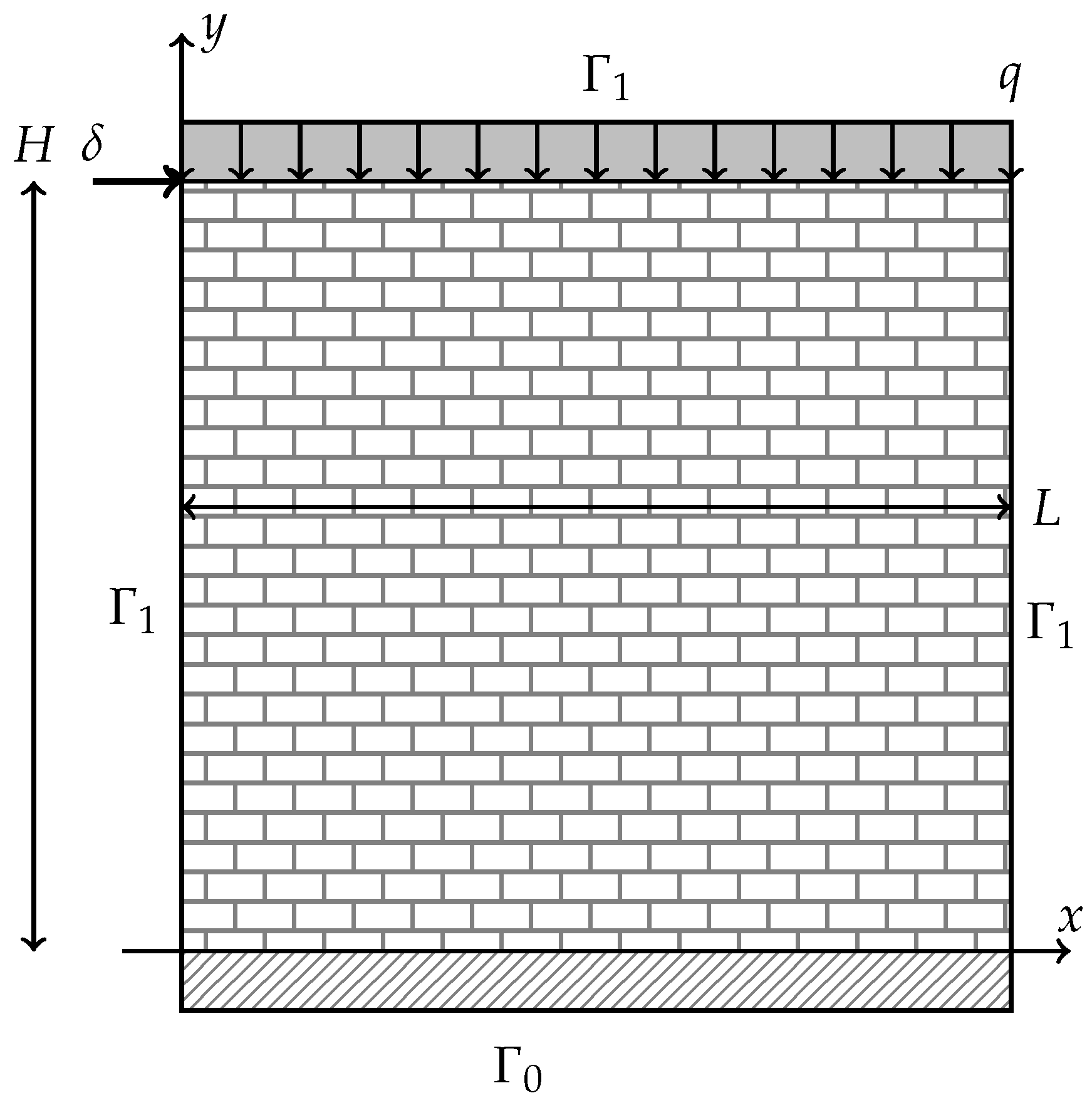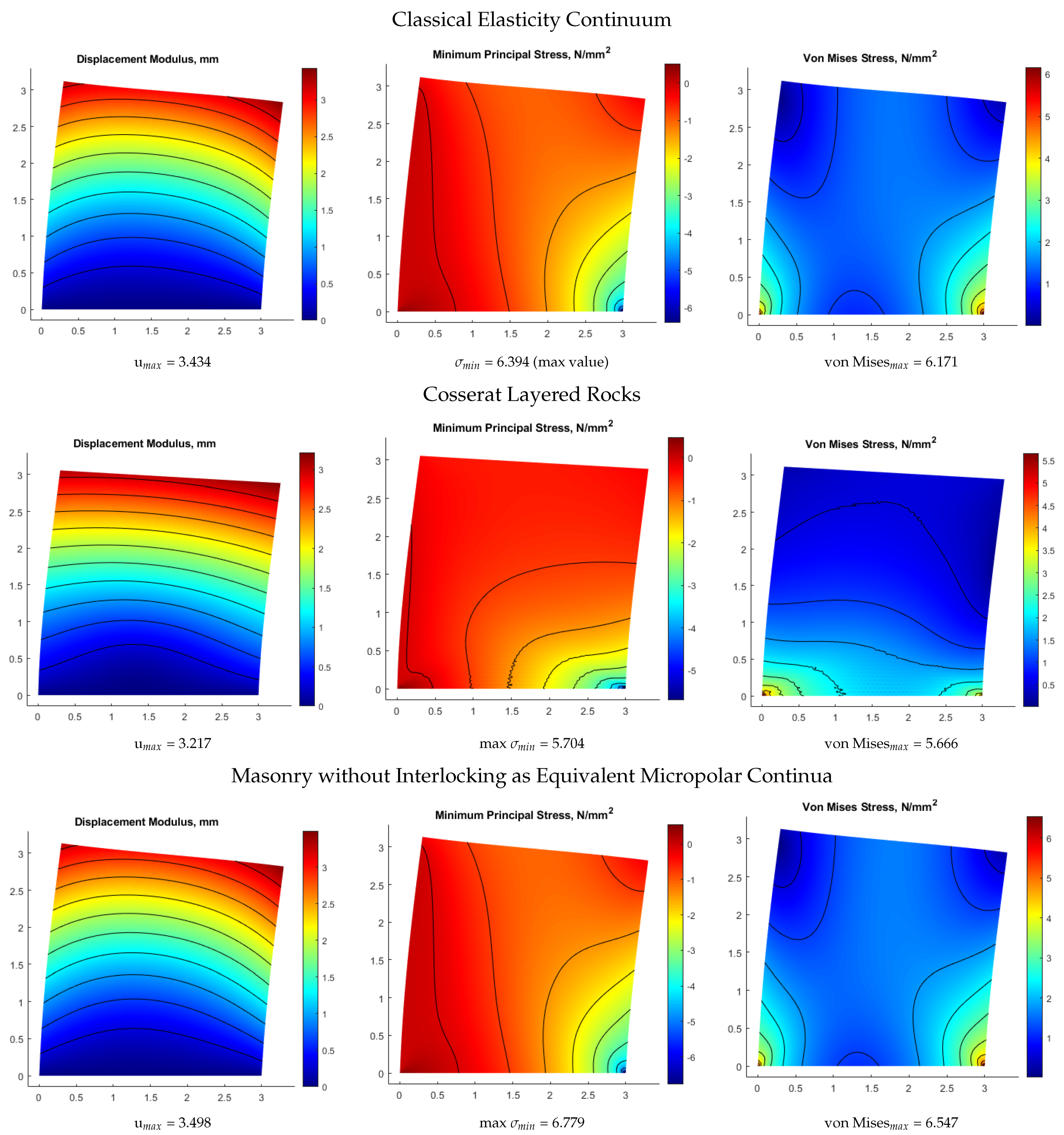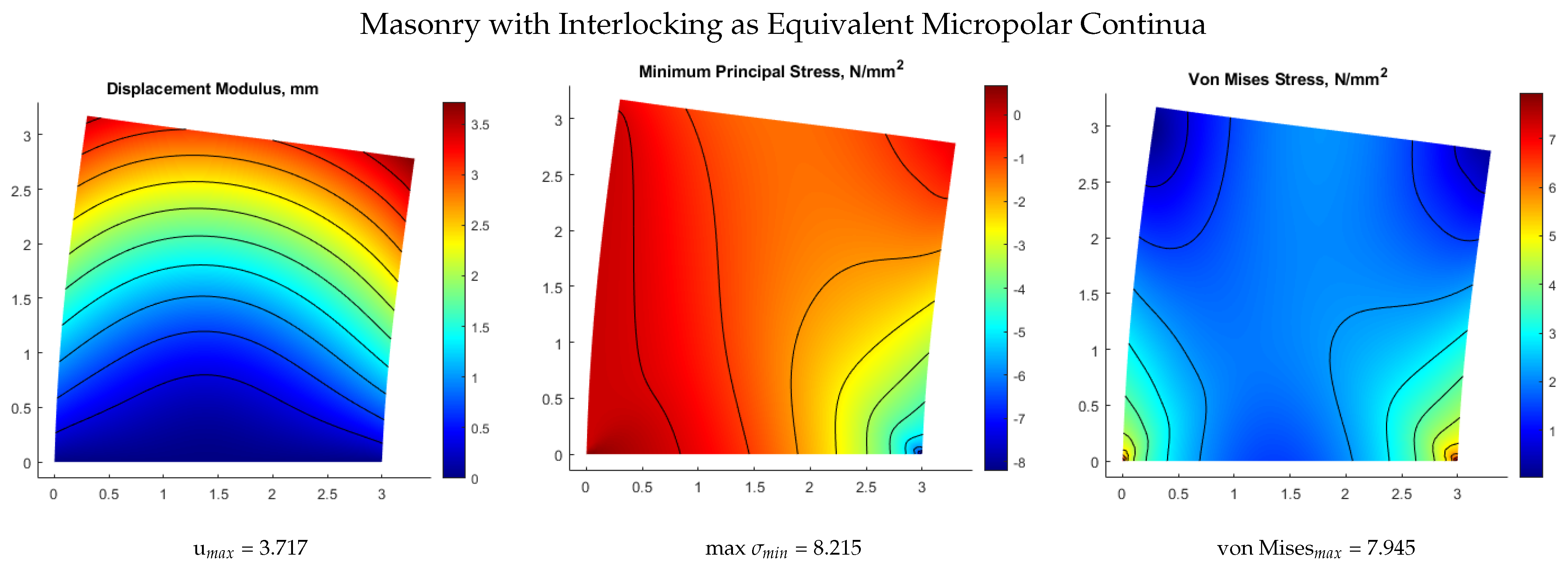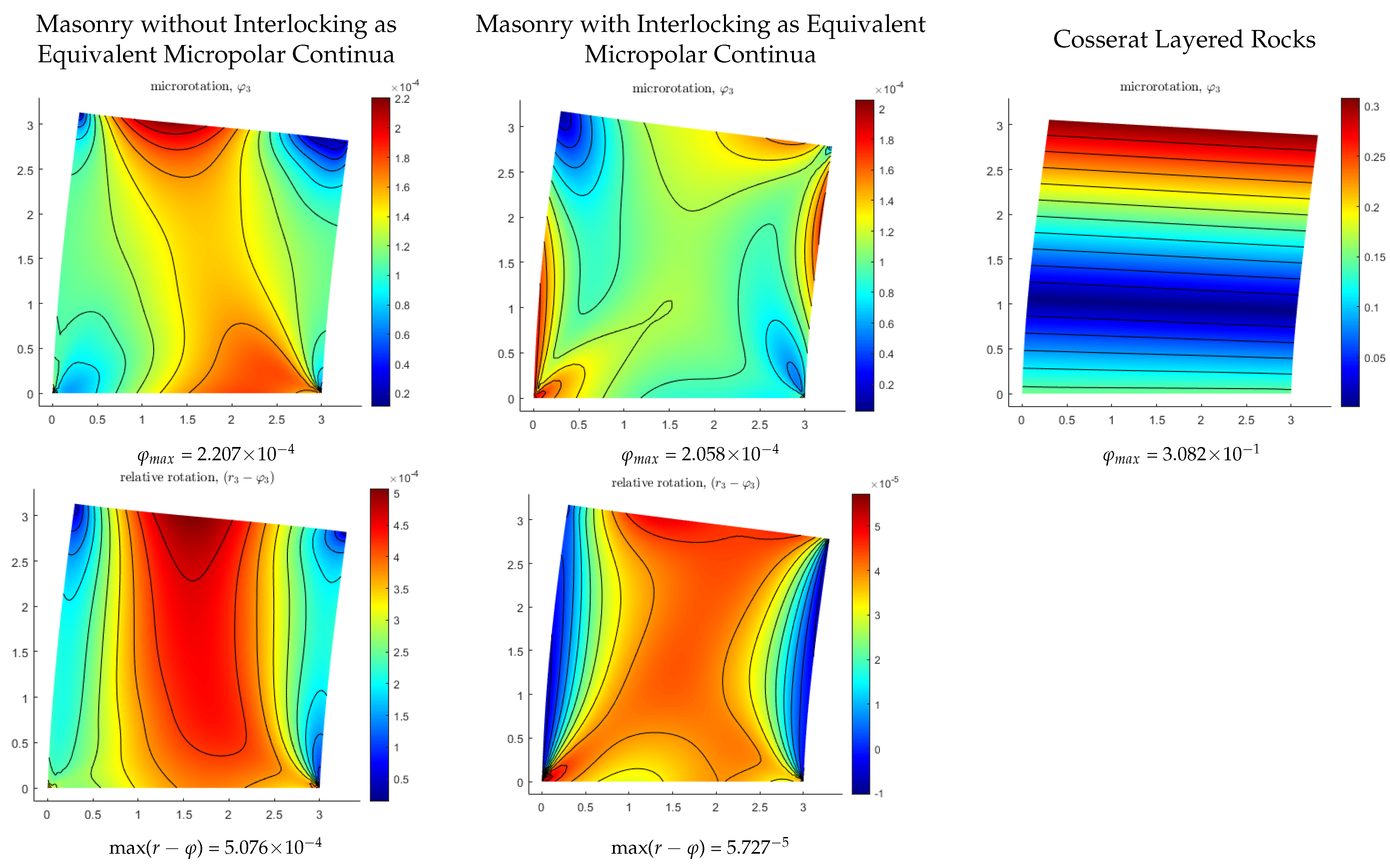Operator Calculus Approach to Comparison of Elasticity Models for Modelling of Masonry Structures
Abstract
:1. Introduction
2. Elasticity Models
2.1. Classical Linear Elasticity
- (i)
- Constitutivewhere are components of the stress tensor, is a volumetric strain, are components of the eulerian strain tensor, and are Lamé coefficients.
- (ii)
- Strain-displacement relationwhere is the displacement vector.
- (iii)
- Equilibrium equationwhere is the stress tensor, is the density of external forces, and is the material density.
2.2. Cosserat Theory of Elasticity
- (i)
- Constitutive equationswhere is the couple stress tensor, is the gradient of the total rotation, and are the Lamé coefficients of classical elasticity, , are moduli used in the couple stress theory; see [15] for details, denotes the modulus of local rotation, and denotes the modulus of the volume flux of local rotation. It is important to mention, that the coefficients and are specific parameters of the Cosserat theory. Additionally, the coefficients and have the same dimensions and thus allowing to introduce the coupling number N:N has the value 0 for classical elasticity and the value 1 for the couple stress theory.
- (ii)
- Strain-displacement relations. The main difference to the classical elasticity is that additionally to the usual strain tensor and the usual rotation tensor , the relative rotation between the triad and the principal axes of strain is introduced as followswhich is also represented by the axial vector
- (iii)
- Equilibrium equationswhere is the coordinate of the body force per unit volume, is the coordinate of the body couple per unit volume, is the symmetric stress tensor, is the skew symmetric stress tensor, and is the couple stress tensor, = , is the permutation tensor and the comma notation is used to indicate a differentiation with respect to the coordinates.
2.3. Micropolar Model
- (i)
- (ii)
- The strain-displacement relations are given by [3]:where is the displacement coordinate.
- (iii)
- Equilibrium equations are given as follows [3]:where is the coordinate of the rotation vector, is the coordinate of the body force per unit volume, is the coordinate of the body couple per unit volume, is the density, is the rotational inertia and is the permutation symbol.
3. Theoretical Model Comparison
3.1. Basics of Quaternionic Analysis
3.2. Construction of Representation Formulae
3.3. Estimates for the Differences between the Models
- The difference between the classical elasticity and the two refined models presented in estimates (9) is controlled by material constants for the Cosserat model and for the micropolar model. Hence, for and the refined solutions should tend to the elasticity solution.
4. Macro-Models and Numerical Results
4.1. Macro-Models for the Micropolar Elasticity and Cosserat Elasticity
4.2. Identification of Additional Material Parameters
4.3. Numerical Comparison of 2D Micro-Models
- parameters of the classical elasticity: Young’s modulus MPa and Poisson ratio .
- parameters of the Cosserat model: m, GPa and GPa.
- parameters of the micropolar model: MPa, , m, m and m.
5. Summary and Conclusions
- The material constants of micropolar and Cosserat elasticity can be used to introduce anisotropies important for the modeling of masonry structures
- Directional strain energies can be used to identify planes of weakness
- To further evaluate the results of this study, future works should correlate the micropolar and Cosserat material constants to masonry continua based on experiments
Author Contributions
Funding
Institutional Review Board Statement
Informed Consent Statement
Data Availability Statement
Conflicts of Interest
References
- Cosserat, E.; Cosserat, F. Théorie des Corps déformables. Nature 1909, 81, 67. [Google Scholar] [CrossRef]
- Eringen, A.C. Linear theory of micropolar elasticity. J. Math. Mech. 1966, 15, 909–923. [Google Scholar]
- Nowacki, W. Theory of micropolar elasticity. In CISM International Centre for Mechanical Sciences; Springer: Wien, Austria, 1970; Volume 25. [Google Scholar]
- Veríssimo-Anacleto, J.; Ludovico-Marques, M.; Neto, P. An empirical model for compressive strength of the limestone masonry based on number of courses—An experimental study. Constr. Build. Mater. 2020, 258, 119508. [Google Scholar] [CrossRef]
- Corrado, C.; Lorenzo, M.; Bassam, A.I. Mesoscale Modeling of a Masonry Building Subjected to Earthquake Loading. J. Struct. Eng. 2021, 147, 04020294. [Google Scholar]
- Shadlou, M.; Ahmadi, E.; Kashani, M.M. Micromechanical modelling of mortar joints and brick-mortar interfaces in masonry Structures: A review of recent developments. Structures 2020, 23, 831–844. [Google Scholar] [CrossRef]
- D’Altri, A.M.; Sarhosis, V.; Milani, G.; Rots, J.; Cattari, S.; Lagomarsino, S.; Sacco, E.; Tralli, A.; Castellazzi, G.; de Miranda, S. Modeling Strategies for the Computational Analysis of Unreinforced Masonry Structures: Review and Classification. Arch. Comput. Methods Eng. 2020, 27, 1153–1185. [Google Scholar] [CrossRef]
- Adhikary, D.P.; Guo, H. An Orthotropic Cosserat Elasto-Plastic Model for Layered Rocks. Rock Mech. Rock Eng. 2002, 35, 161–170. [Google Scholar] [CrossRef]
- Trovalusci, P.; Pau, A. Derivation of microstructured continua from lattice systems via principle of virtual works: The case of masonry-like materials as micropolar, second gradient and classical continua. Acta Mech. 2014, 225, 157–177. [Google Scholar] [CrossRef]
- Lakes, R.S. Cosserat Elasticity; Micropolar Elasticity. University of Wisconsin. 2020. Available online: http://silver.neep.wisc.edu/lakes/Coss.html (accessed on 20 January 2020).
- Lakes, R.S. Experimental micro mechanics methods for conventional and negative poisson’s ratio cellular solids as cosserat continua. J. Eng. Mater. Technol. 1991, 113, 148–155. [Google Scholar] [CrossRef] [Green Version]
- Lurie, A.I. Theory of Elasticity; Springer: Berlin/Heidelberg, Germany, 2005. [Google Scholar]
- Timoshenko, S.P.; Goodier, J.N. Theory of Elasticity; McGraw-Hill Publishing Company: New York, NY, USA, 1970. [Google Scholar]
- Cowin, S.C. Stress functions for cosserat elasticity. Int. J. Solids Struct. 1970, 6, 389–398. [Google Scholar] [CrossRef]
- Mindlin, R.D.; Tiersten, H.F. Effects of couple-stresses in linear elasticity. Arch. Ration. Mech. Anal. 1962, 11, 415–448. [Google Scholar] [CrossRef]
- Gürlebeck, K.; Sprößig, W. Quaternionic and Clifford Calculus for Physicists and Engineers; Wiley: Chichester, UK, 1997. [Google Scholar]
- Gürlebeck, K.; Legatiuk, D. Quaternionic operator calculus for boundary value problems of micropolar elasticity. In Topics in Clifford Analysis; Series “Trends in Mathematics”; Springer: Berlin/Heidelberg, Germany, 2019; pp. 221–234. [Google Scholar]
- Gürlebeck, K.; Habetha, K.; Sprößig, W. Application of Holomorphic Functions in Two and Higher Dimensions; Springer: Berlin/Heidelberg, Germany, 2016. [Google Scholar]
- Adhikary, D.P.; Dyskin, A.A. Continuum Model of layered rock masses with non-associative joint plasticity. Int. J. Numer. Anal. Methods Geomech. 1998, 22, 245–261. [Google Scholar] [CrossRef]
- Pau, A.; Trovalusci, P. Block masonry as equivalent micropolar continua: The role of relative rotations. Acta Mech. 2012, 223, 1455–1471. [Google Scholar] [CrossRef]
- Adomeit, G. Determination of elastic constants of a structured material. In Mechanics of Generalized Continua; Kroner, E., Ed.; IUTAM-Symposium; Springer: Berlin/Heidelberg, Germany, 1968; pp. 80–82. [Google Scholar]
- Herrmann, G.; Achenbach, J.D. Applications of Theories of Generalized Continua to the Dynamics of Composite Materials. In Mechanics of Generalized Continua; Kroner, E., Ed.; IUTAM-Symposium; Springer: Berlin/Heidelberg, Germany, 1968; pp. 69–79. [Google Scholar]
- Bažant, Z.P.; Christensen, M. Analogy between micropolar continuum and grid frameworks under initial stress. Int. J. Solids Struct. 1972, 8, 327–346. [Google Scholar] [CrossRef] [Green Version]
- Kanatani, K.I. A micropolar continuum model for vibrating grid frameworks. Int. J. Eng. Sci. 1979, 17, 409–418. [Google Scholar] [CrossRef]
- Noor, A.K.; Nemeth, M.P. Analysis of spatial beamlike lattices with rigid joints. Comput. Methods Appl. Mech. Eng. 1980, 24, 35–59. [Google Scholar] [CrossRef]
- Askar, A. Molecular crystals and the polar theories of the continua; Experimental values of material coefficients for kno3. Int. J. Eng. Sci. 1972, 10, 293–300. [Google Scholar] [CrossRef]
- Perkins, R.W.; Thompson, D. Experimental evidence of a couple-stress effect. AIAA J. 1973, 11, 1053–1055. [Google Scholar] [CrossRef]
- Gauthier, R.D.; Jahsman, W.E. A quest for micropolar elastic constants. Ser. E J. Appl. Mech. Trans. ASME 1975, 42, 369–374. [Google Scholar] [CrossRef]
- Gauthier, R.D.; Jahsman, W.E. Bending of a curved bar of micropolar elastic material. Ser. E J. Appl. Mech. Trans. ASME 1976, 43, 502–503. [Google Scholar] [CrossRef]






| Strain Energy | Classical Elasticity | Cosserat Layered Rocks | Masonry without Interlocking | Masonry with Interlocking |
|---|---|---|---|---|
| 4.502 | 1.033 | 7.227 | 9.586 | |
| 17.565 | 18.692 | 21.374 | 31.759 |
| Coefficients of and | max von Mises | |||||
|---|---|---|---|---|---|---|
| mm | N/mm2 | N/mm2 | ||||
| 1 × 109 | 5 × 108 | 4.536 × 109 | 3.726 | 8.240 | 7.971 | |
| 1 × 108 | 5 × 107 | 4.536 × 109 | 3.718 | 8.217 | 7.948 | |
| 1 × 107 | 5 × 106 | 4.536 × 109 | 3.717 | 8.215 | 7.946 | |
| 1 × 106 | 5 × 105 | 4.536 × 109 | 3.717 | 8.215 | 7.945 | |
| 1 × 105 | 5 × 104 | 4.536 × 109 | 3.717 | 8.215 | 7.945 | |
| 1 × 104 | 5 × 103 | 4.536 × 109 | 3.717 | 8.215 | 7.945 | |
| 1 × 103 | 5 × 102 | 4.536 × 109 | 3.717 | 8.215 | 7.945 | |
| 1 × 102 | 5 × 101 | 4.536 × 109 | 3.717 | 8.215 | 7.945 | |
| 1 × 101 | 5 × 100 | 4.536 × 109 | 3.717 | 8.215 | 7.945 | |
| 1 × 100 | 5 × 10−1 | 4.536 × 109 | 3.717 | 8.215 | 7.945 | |
| 0 | 0 | 4.536 × 109 | 3.717 | 8.215 | 7.945 | |
| 0 | 0 | 0 | 3.415 | 6.248 | 6.029 | |
| 6.094 × 106 | 1.219 × 106 | 4.536 × 109 | 3.717 | 8.215 | 7.945 | Micropolar with interlocking |
| - | - | - | 3.434 | 6.394 | 6.170 | Classical Elasticity |
Publisher’s Note: MDPI stays neutral with regard to jurisdictional claims in published maps and institutional affiliations. |
© 2022 by the authors. Licensee MDPI, Basel, Switzerland. This article is an open access article distributed under the terms and conditions of the Creative Commons Attribution (CC BY) license (https://creativecommons.org/licenses/by/4.0/).
Share and Cite
Gürlebeck, K.; Legatiuk, D.; Webber, K. Operator Calculus Approach to Comparison of Elasticity Models for Modelling of Masonry Structures. Mathematics 2022, 10, 1670. https://doi.org/10.3390/math10101670
Gürlebeck K, Legatiuk D, Webber K. Operator Calculus Approach to Comparison of Elasticity Models for Modelling of Masonry Structures. Mathematics. 2022; 10(10):1670. https://doi.org/10.3390/math10101670
Chicago/Turabian StyleGürlebeck, Klaus, Dmitrii Legatiuk, and Kemmar Webber. 2022. "Operator Calculus Approach to Comparison of Elasticity Models for Modelling of Masonry Structures" Mathematics 10, no. 10: 1670. https://doi.org/10.3390/math10101670
APA StyleGürlebeck, K., Legatiuk, D., & Webber, K. (2022). Operator Calculus Approach to Comparison of Elasticity Models for Modelling of Masonry Structures. Mathematics, 10(10), 1670. https://doi.org/10.3390/math10101670






